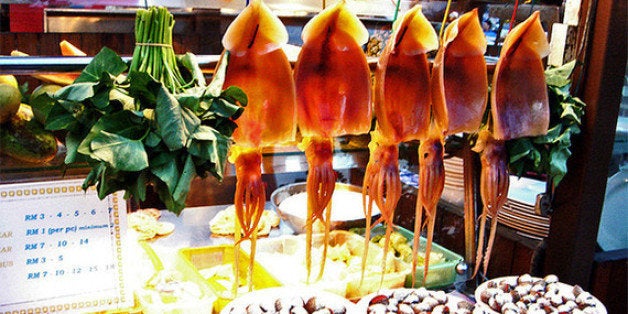
Memories, souvenirs, and photos are all great things to bring home from a trip. Less wonderful are E. coli, Hepatitis A, typhoid fever, and other byproducts of tainted food. As counterintuitive as it may seem, you may have to say "no" to some foods in order to say "yes" to a great trip.
Here's our shortlist of foods you should think twice about before tucking into while traveling, especially if you're in a place where water quality is an issue. And before you start eating like a local, remember that you haven't spent years training your immune system to withstand the local bacteria. But take heart: At least cake is usually safe wherever you go.
Local Hooch
Artisanal, craft, and ultra-micro-brew may be all the rage, but when you're trying to stay healthy while traveling, don't take it so far that you stray into the potentially dangerous world of moonshine, rotgut, and hooch. Questionable water, storage, and alcohol levels of homemade brews can lead to sometimes serious illness, especially for uninitiated non-locals.
Unpasteurized Dairy
Drinking unpasteurized milk, or eating unpasteurized dairy products like cheese or ice cream, is 150 times more likely to cause a foodborne illness than sticking to pasteurized dairy products, according to the FDA. Pasteurization (or the process of irradiation, in some countries) kills salmonella, E. coli, listeria, and other harmful bacteria that can be found in raw milk.
Related: 5 Foreign Foods That Can Kill You
Salad
Craving a crisp salad? Think twice before picking up your fork: The World Health Organization advises against green-leafed vegetables, since they can contain dangerous microorganisms that won't necessarily wash off with water. And in places where the water is of questionable quality, washing can actually compound the problem.
Fish and Shellfish
Bad news: Fish and shellfish may be delicious, but they can also be the source of some truly gnarly illnesses. For instance, anisakiasis is a raw-fish-based invasion of worms in the human gastrointestinal tract. Shellfish poisoning, meanwhile, can have paralytic, neurotoxic, or amnestic symptoms. Other types of seafood poisoning can cause vomiting, diarrhea, and even the sensation that your teeth are about to fall out.
Buffet Foods
Buffets present a series of logistical food-safety challenges. Keeping foods from spoiling requires constant attention, but buffet food sits unattended for hours. People can cough or sneeze on the food, or touch it with their unwashed hands. Flies easily land—and poop—on food exposed to the air. And then there's the temperature problem: Hot foods need to stay piping hot, and cold foods must remain refrigerator-cold to ward off bacteria growth. With so many elements working against your intestinal health, it's better to steer clear of buffets anywhere you're not 100 percent confident of food handling and safety techniques.
Raw Eggs
Want to avoid foodborne illness in another country? Then skip runny eggs, novelty cocktails, homemade mayonnaise, and other products that rely on raw or undercooked eggs. If you're preparing local eggs yourself, don't wash or soak them, either—according to the University of Michigan, doing so can drive bacteria from the shell into the interior of the egg.
Certain Fruits
Fruit has its own special place in the traveler food safety adage, "Boil it, cook it, peel it, or forget it!" Avoid fruits that don't come with a built-in thick peel. The good news is that fruits with a thick peel are protected from tainted water and soil, and are considered safe to eat just about everywhere. Bananas, mangoes, pineapple, and papayas are among the delicious fruit protected by their own tough peels. For maximum safety, peel the fruit yourself, and make sure any cutting implements are clean and dry when you start.
Undercooked Meat
Undercooked meat often tastes really good. But you still might consider avoiding it, at least when you're not 100 percent confident about its path from farm to table. Raw meat presents two layers of potential contamination. The exterior surface is basically a canvas for enteric pathogens, but these are easily killed off by cooking. However, there's also the chance of parasitic pathogens in the muscle tissue, and that's why food safety experts make such a big deal about cooking meat to an internal temperature of 160 degrees Fahrenheit.
Bush Meat
Even the most adventurous carnivores should avoid eating monkey, bats, and wild game if gastrointestinal health is a priority. The CDC advises against eating "bush meat," the flesh of undomesticated animals. Raw bush meat has been suspected of creating a transmission bridge for Ebola and other animal-to-human viruses. Cooked, the meat can still be problematic, especially for travelers whose bodies are unused to local bacteria. And conservationists suggest avoiding bush meat since it could come from endangered or threatened species.
Popsicles
At first glance, a fun frozen treat like popsicles may seem like the most innocuous item on this list. But poor-quality water, fruit without thick peels, and unpasteurized dairy are often the main ingredients, making popsicles a triple threat in places where food safety may be an issue. If you're in a place where you're avoiding the water, do yourself a flavor and put that ice pop down, too.
--By Christine Sarkis
Read the original story: 10 Foods You Should Never Eat Overseas by Christine Sarkis, who is a regular contributor to SmarterTravel.
Related
Before You Go

어디에서 먹을까: 베트남 호치민
베트남어로 '반미'는 모든 빵을 뜻하는데, 어쩌다 보니 맛있는 베트남식 호기(hoagie) 샌드위치를 뜻하는 단어로 바뀌었다. 프랑스 식민지 시대가 동남아시아에 끼친 영향이라고 할 수 있는 반미는 서양과 동양 음식의 매끄러운 조합이다. 내용물에 차이가 있을 수 있지만 기본은 바게트에 고기(구운 돼지고기, 미트볼, 또는 냉장 육류), 오이, 고수, 당근, 무, 간 파테, 그리고 마요네즈가 들어간다. 서양에서도 인기가 좋아 흔하게 찾을 수 있는데 원조와 그 내용물은 좀 다를 수 있다. 그러나 제대로 먹으려면 아직도 사이공 길거리에서 먹는 게 최고다.
Plan Your Trip: Visit Fodor’s Vietnam Travel Guide
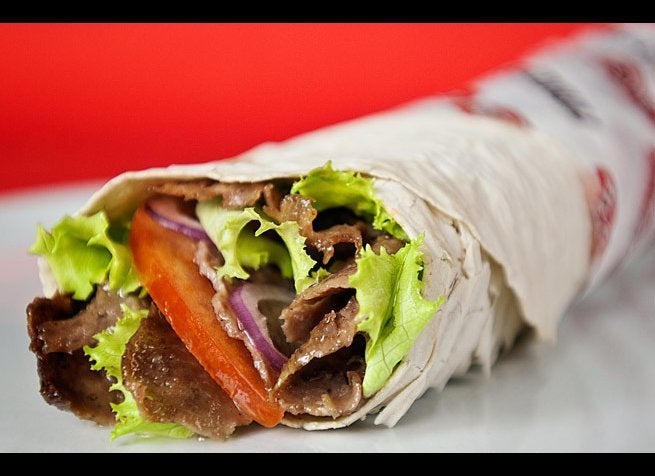
어디서 먹을까 : 터키 이스탄불
듀륨을 번역하면 '쌈'이다. 아르메니아의 빵 라보시(lavash)나 터키 빵 유프카 같은 플랫브레드(flatbread, 얇은 웨하스 모양의 크래커)로 만드는데 안에는 일반적으로 도네르(döner) 케밥 재료와 비슷한 게 들어간다. 양념된 고기(일반적으로 양고기지만 닭고기 또는 소와 양고기를 섞기도 한다)를 꼬챙이에 세워서 구운 후, 잘라서 토마토와 양파, 오이, 양상추, 그리고 허브를 듬뿍 넣은 요거트 또는 핫소스를 더한다. 유럽에서 밤늦게까지 놀아본 적이 있다면 아마 술과 함께 듀륨을 먹어 본 적이 있을 거다. 도네르(샤왈마Shawarma라고도 부른다)는 독일에서 가장 인기가 좋은 길거리 음식이다. 하지만 껍질을 바삭하게 구워 속을 채운 터키 버전이 정말로 환상적이다.
Plan Your Trip: Visit Fodor’s Istanbul Travel Guide
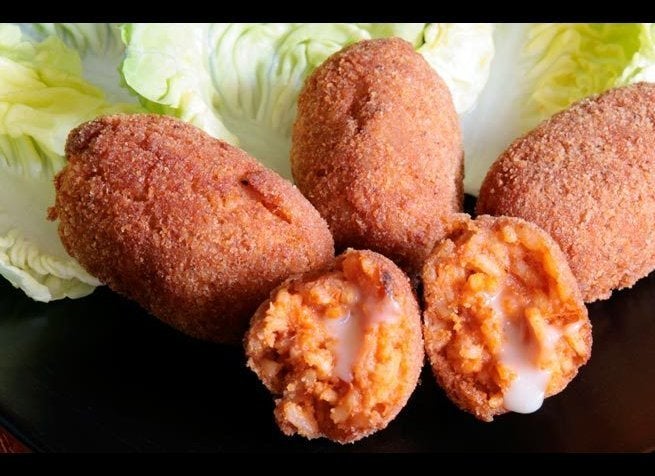
어디서 먹을까 : 이탈리아 로마
이탈리아 시실리의 주먹밥 아란치니의 동생 버전인 이 음식은 쌀로 만든 공처럼 생겼다. 그 안에 모차렐라 치즈가 '서프라이즈surprise(프랑스어로 읽으면 수플리suppli)'하게 들어있다고 그 이름을 붙었다. 예전에는 속에 닭 모래주머니까지 넣었는데, 지난 100년 동안은 거의 변화가 없었다. 쌀, 간 소고기와 토마토가 들어있는 라구 소스, 그리고 모차렐라 치즈가 그 내용물이었다. 예전에는 주로 길거리 상인이 수플리를 취급했는데 요즘은 피자 가게나 슈퍼에서도 먹을 수 있다. 전통 레시피가 아직도 왕성한 인기를 누리지만 새로운 레시피가 속속 소개되고 있다.
Plan Your Trip: Visit Fodor’s Rome Travel Guide
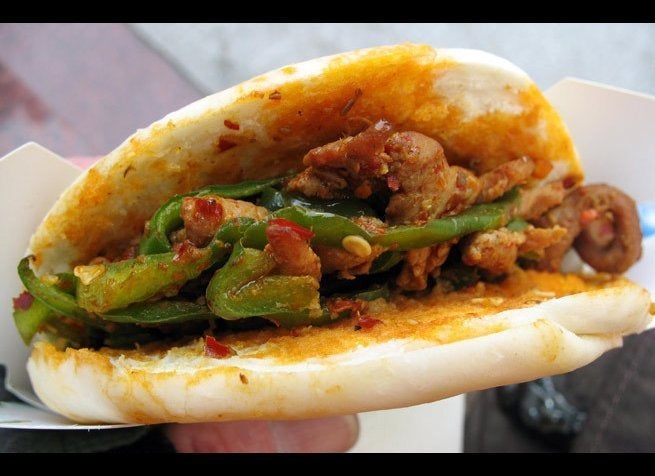
어디서 먹을까: 중국 산시성 시안
중국식 도네르 케밥이라고 생각하면 된다. 로우쟈모는 세상에서 가장 오래 된 샌드위치 중에 하나다. 그 역사가 약 2,000년은 넘는다. 전통 레시피는 플랫브레드 안에 몇 시간 동안 양념한 돼지고기(카레가 듬뿍 들어갔다)와 고수, 피망을 넣는다. (무슬림 지역에서는 돼지 대신 소고기를 이용하며 지역에 따라 양고기도 인기가 인 곳도 있다.) 로우쟈모는 중국 산시성이 그 원조인데(진시황의 병마용으로 유명한 그곳!) 이젠 중국 전역에서 다 맛볼 수 있다. 특히 북쪽 도시에서는 흔한 길거리 음식이다. 베이징을 방문할 예정이라면 달걀, 고수, 중국식 만두인 완탕을 튀긴 과자(이름은 지안빙, 우리말로 '전병'과 비슷하다)가 들어있는 로우쟈모를 먹어 보자.
Plan Your Trip: Visit Fodor’s Silk Road Travel Guide
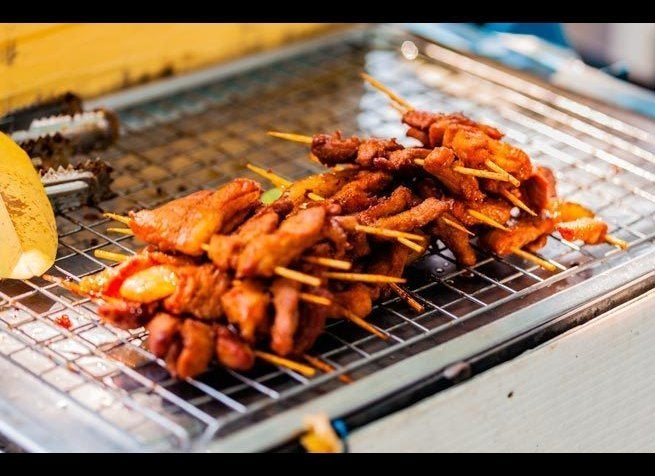
어디서 먹을까: 태국 방콕
동남아시아에서는 거의 어딜 가든 소고기와 닭고기 사테를 만날 수 있는데 태국에서는 돼지고기 사테가 가장 인기가 좋다. 고기를 얇게 썰어 코코넛 우유와 강황, 그리고 다른 향신료로 양념한 장에 재워둔 후 꼬치에 끼워 그릴 위에서 굽는다. 그런데 그게 다가 아니다. 사테에는 보통 절인 오이 샐러드와 달콤새콤한 땅콩 소스를 곁들인다. 사테는 인도네시아에서 유래된 음식인데 태국 사람들이 얼마나 좋아하는지 길거리 어디에서든 볼 수 있으며 사람들이 태국 전통 음식으로 착각할 때도 잦다.
Plan Your Trip: Visit Fodor’s Bangkok Travel Guide

어디서 먹을까: 멕시코
훌륭한 음식들이 으레 그렇듯 타코 알 파스토르는 여러 문화가 섞인 결과물이다. 예전에 멕시코에 이민 온 레바논인들이 불 위에 양고기를 돌려 굽는 방법을 소개했었다. 그런데 멕시코에서는 양고기가 돼지고기로 바뀌었고 마른 고추와 다양한 향신료 그리고 파인애플에 고기를 재운 후 굽게 됐다. 레바논 음식 샤왈마처럼 쇠꼬챙이에 매달린 고기를 잘라내서 작은 또띠야에 얹은 후, 양파와 고수 그리고 취향에 때라 파인애플을 올려 먹는다. 또 라임 주스와 매운 살사를 얹는 것도 유행이다.
Plan Your Trip: Visit Fodor’s Mexico City Travel Guide
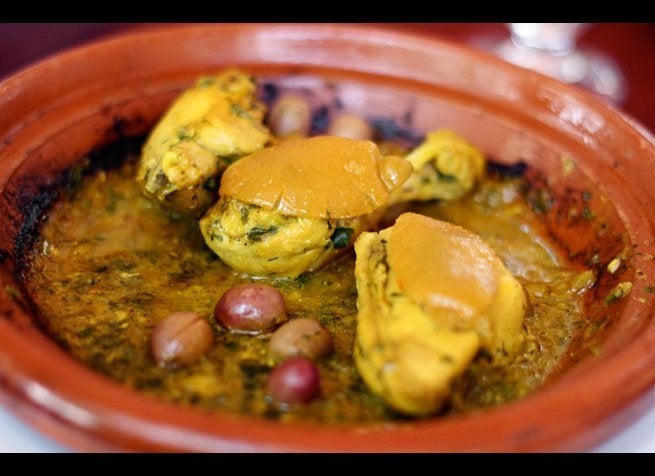
어디서 먹을까 : 모로코 마라케시
질그릇 이름 '타진'을 딴 이 요리는 북아프리카 베르베르족 음식에서 기원했으며 뜨거운 숯 위에 천천히 익힌다. 여러 종류의 타진이 있는데, 기본 재료는 고기(양고기, 닭고기, 소고기), 채소, 그리고 다양한 허브와 향신료다. 과일과 견과류를 넣는 경우도 많다. 쿠스쿠스나 빵과 함께 주로 서빙되는데 모로코의 노점부터 고급 레스토랑까지 어디서든 찾을 수 있다. 그래도 가장 맛있게 먹는 방법은 길거리에서 편하게 먹는 것이다.
Plan Your Trip: Visit Fodor’s Marrakesh Travel Guide
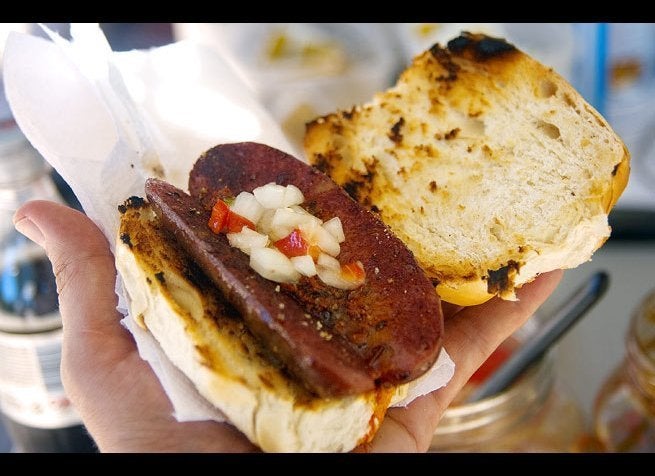
어디서 먹을까 : 부에노스아이레스
이 소시지 샌드위치는 남미 모든 국가에서 큰 인기를 누리는 길거리 음식이다. 브라질, 칠레, 아르헨티나, 우루과이, 페루, 볼리비아, 베네수엘라 등등. 그중에 아르헨티나 초리빤은 매우 단순하다. 구운 소고기 또는 돼지고기 소시지를 반으로 갈라 바삭바삭한 빵 사이에 넣은 후 마늘 향이 강한 치미추리 소스를 뿌린다. 경기를 관람하는 운동장에서도 매우 인기가 높지만 아무때나 길거리에서 쉽게 찾아볼 수 있다.
Plan Your Trip: Visit Fodor’s Buenos Aires Travel Guide

어디서 먹을까 : 인도 뭄바이
인도의 길거리 음식을 챠트(chaat)라고 한다. 지역별로 종류가 매우 다양한데 적어도 벨 푸리는 거의 어디에 가서나 먹을 수 있는 음식이다. 그래도 뭄바이가 벨 푸리를 먹기에는 가장 좋은 곳인데, 불린 쌀, '세브(sev)'라는 튀긴 면, 채소, 향신료 그리고 처트니(과일・설탕・향신료와 식초로 만드는 걸쭉한 소스)가 포함된다. 그 결과는 달콤, 짭짤, 새콤, 매콤한 환상적인 맛이다. 이 음식은 특히 뭄바이 해변과 어울리는데, 도시 어디에서든 길거리 상인을 만날 수 있다.
Plan Your Trip: Visit Fodor’s Mumbai Travel Guide
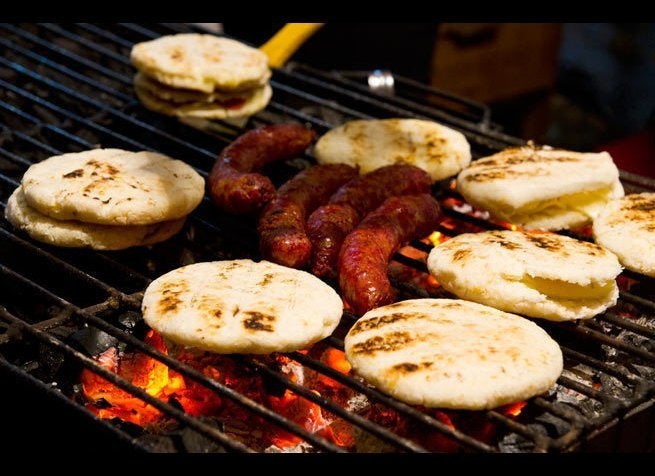
어디서 먹을까 : 콜롬비아 보고타
아레빠는 아침 식사 또는 오후 간식으로 주로 먹는다. '아레빠'는 옥수수나 밀가루로 만든 플랫브레드를 뜻하는데 불에 직접 구워도 되고 오븐에 구워도 되며 튀겨도 좋다. 베네수엘라에서는 아레빠를 주로 샌드위치 빵으로 이용하는데 콜롬비아는 다르다. 콜롬비아에서는 아레빠 위에 양파, 치즈, 달걀, 연유, 초리조, 그리고 양파즙으로 만든 '호가오'라는 소스를 올린다. 만약에 진짜 보고타 사람 처럼 행세하고 싶다면 아무것도 얹지 않은 아레빠와 핫 초콜릿을 아침으로 먹어보자.
Plan Your Trip: Visit Fodor’s Bogotá Travel Guide
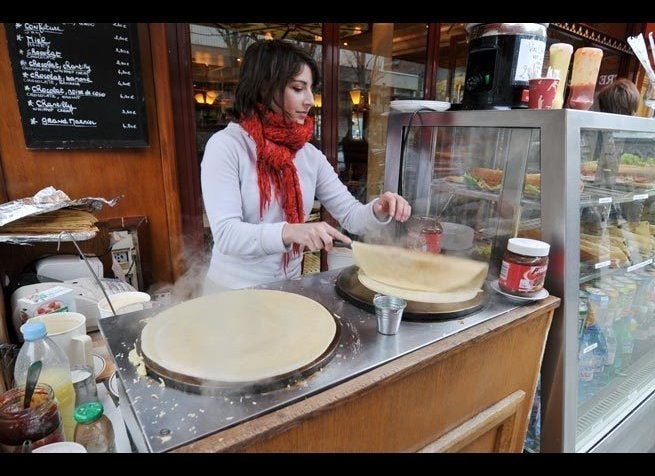
어디서 먹을까 : 프랑스 파리
파리에서 온종일 만날 수 있는 크레페는 모든 파리지앵이 좋아하는 간식이다. 메밀로 만든 맛있는 크레페는 햄과 치즈를 넣어 점심이나 저녁에 먹는다. 물론 달걀이나 채소 또 다른 고기를 넣은 크레이프도 찾을 수 있다. 달콤한 크레이프는 주로 아침이나 간식으로 먹는데 설탕, 잼, 커스터드 크림, 또는 악마의 크림 누뗄라를 바른다. 다양한 크레페 종류를 시식하고자 한다면 몽파르나스로 가자. 각자의 예산에 맞는 다양한 크레이프를 만날 수 있다.
Plan Your Trip: Visit Fodor’s Paris Travel Guide
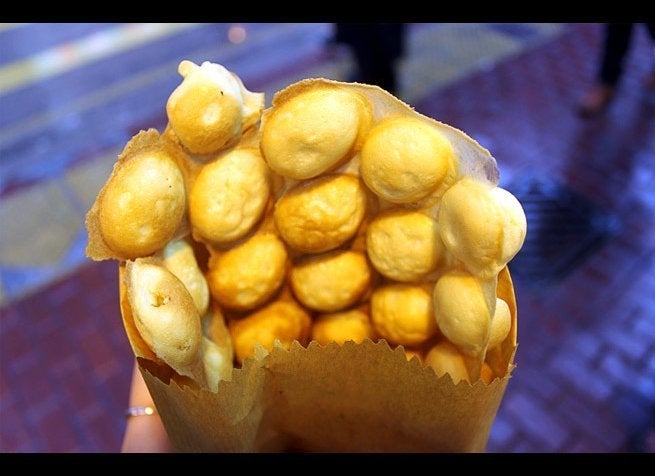
어디서 먹을까 : 홍콩
홍콩 계란빵은 50년대에 길거리에 처음 나타났는데 그 이후로 지속적인 인기를 누리고 있다. 독특한 원 모양은 홈이 패인 두 개의 쇠판 사이에 밀가루 반죽을 구워서다. 계란빵은 굽자마자 먹어야 제맛이다. 보통 아무것도 첨가하지 않고 먹지만 초콜릿이나 녹차 또는 생강 맛을 밀가루에 첨가하는 경우도 있다.
Plan Your Trip: Visit Fodor’s Hong Kong Travel Guide

어디서 먹을까 : 브라질 리우데자네이루
포르투갈말로 '에스페티노'는 작은 꼬치라는 뜻이다. 리우데자네이루는 물론 여러 브라질 도시에서 만날 수 있는 길거리 음식이다. 가장 많이 먹는 것은 소고기, 닭고기 꼬치인데 쇠꼬챙이에 낄 수 있는 거라면 뭐든지 가능하다. 소시지, 핫도그, 새우, 생선 덩어리, 또는 녹지 않는 케이호 코알로(queijo coalho)는 치즈까지 말이다. 상인들은 보통 매운 소스와 브라질 사람들이 고기 위에 뿌려 먹기 좋아하는 바삭바삭한 밀가루 부스러기인 '파린하( farinha)'를 준비해 놓는다.
Plan Your Trip: Visit Fodor’s Rio de Janeiro Travel Guide
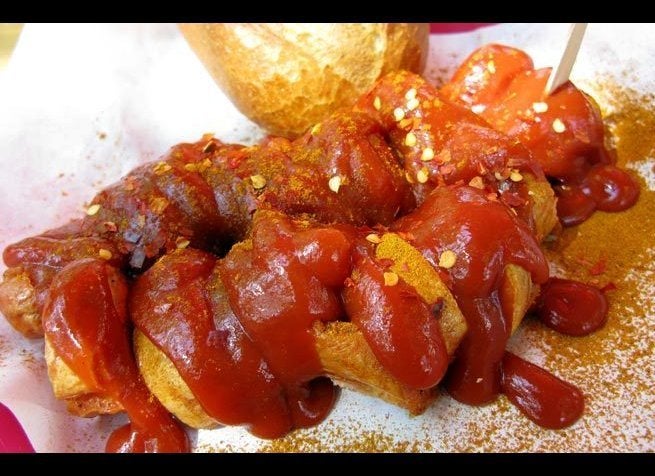
어디서 먹을까 : 독일 베를린
1949년 독일에서 탄생한 이 음식 최근 독일을 상징하는 음식으로 탈바꿈하였다. 돼지고기 소시지(브라트부르스트)를 튀긴 후 케첩과 커리 가루를 뿌려 빵 또는 감자튀김과 서빙한다. 커리부르스트는 독일 전역에서 팔리는데 연간 약 8억 개가 소비된다고 한다. 특히 함부르크와 베를린에서 인기가 대단하다. 소시지는 보통 통째로 서빙되는데 미리 잘라서 내는 곳도 간혹 있다.
Plan Your Trip: Visit Fodor’s Berlin Travel Guide

어디서 먹을까 : 이스라엘 텔아비브
팔라펠의 기원은 잘 알려지지 않았을뿐더러, 기원에 대한 논쟁도 상당하다. 이집트, 팔레스타인, 이스라엘 등 여러 국가에서 민속음식이라고 주장하고 있다. 어쨌든 팔라펠은 이스라엘에서 음식문화에 큰 부분을 차지하는데 사람들은 국가를 대표하는 음식으로도 여긴다. 팔라펠이라는 단어는 원래 병아리콩으로 만든 동그란 튀김을 뜻하는 말인데, 튀김이 들어있는 샌드위치를 말하기도 한다. 넓적한 피타(pita)빵에 팔레펠을 넣어 서빙하는데 샐러드와 피클, 핫소스, 향신료, 그리고 참깨로 만든 타히니 소스를 뿌린다. 세계 여러 곳에서 팔라펠을 먹을 수 있지만 텔아비브 길거리에서 먹는 팔라펠의 맛은 일품이다.
Plan Your Trip: Visit Fodor’s Tel Aviv Travel Guide
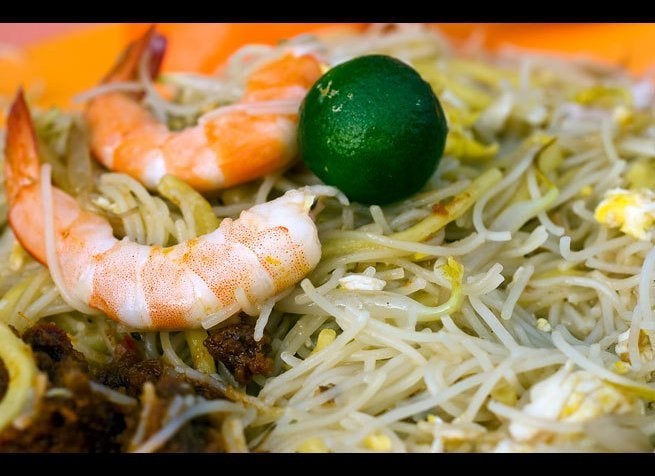
어디서 먹을까 : 싱가폴
길거리 음식으로 유명한 나라 중에 싱가폴을 빼놓을 수 없다. 계란면에 해산물을 함께 볶은 호키엔 미는 꼭 먹어봐야 하는 싱가폴 음식이다. 2차 세계대전 이후 중국 후난에서 싱가폴로 이주한 중국인 선원들이 발명한 음식으로, 쌀국수와 계란국수, 돼지고기, 달걀, 새우, 오징어, 마늘과 간장을 넣고 볶는다. 라임 또는 '삼발'로 불리는 칠리소스를 곁들인다. 예전에는 비계 덩어리를 한 조각 넣어다는데, 건강 차원에서 이러한 전통은 사라졌다고 한다.
Plan Your Trip: Visit Fodor’s Singapore Travel Guide

어디서 먹을까 : 자메이카
저크 치킨은 자메이카가 수출하는 음식 중 가장 유명하지만, 자메이카에서 직접 먹어봐야 제맛을 알 수 있다. 왜냐면 누구든 저크 소스(다양한 베리류 소스, 타임, 아주 매운 고추 '스카치 보넷', 파, 생강, 기름 또는 간장)를 만들어 고기를 재울 수 있지만 자메이카에서는 누구보다 치킨을 제대로 굽기 때문이다. 모든 저크 치킨을 숯불에 굽는데, 그래서 고기가 바삭하고 연기에 그을린 맛이 난다. 자메이카에서는 장작 위에 나뭇잎을 놓은 후 그 위에 치킨을 직접 굽는다. 그래야 닭에서 나오는 기름이 빠져 맛이 좋아진다.
Plan Your Trip: Visit Fodor’s Jamaica Travel Guide
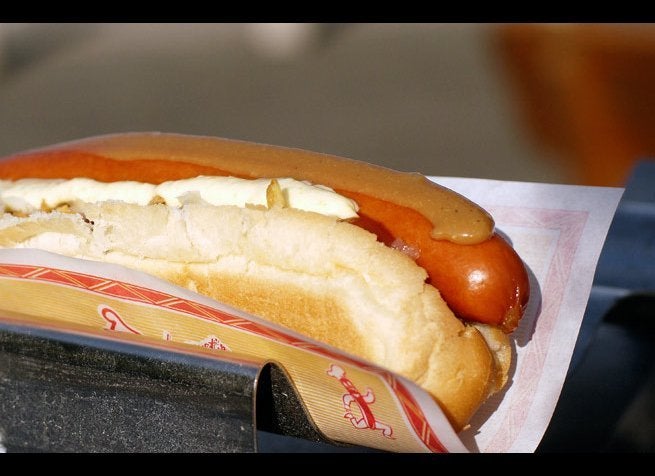
어디서 먹을까 : 아이슬란드 레이캬비크
삭힌 상어, 양 머리, 고래 고기는 잊어라! 아이슬란드인들이 정말 좋아하는 음식은 핫도그다. 음식을 파는 곳에선 거의 찾을 수 있는데 레이캬비크의 Bæjarins Beztu Pylsur(바이야린스 베스튀 필쉬르), 즉 '도시에서 가장 맛있는 핫도그' 가게가 가장 유명하다. 1937년에 바닷가에 문을 연 이 식당은 미국 전 대통령 빌 클린턴을 비롯해 수많은 사람이 찾아왔다. 아이슬란드의 핫도그가 독특한 이유는 주재료가 양고기고 약간의 소고기와 돼지고기가 포함되어 있기 때문이다. 토핑으로는 케첩, 머스터드, 피클을 다져 넣은 마요네즈, 생 양파, 그리고 튀긴 양파다. 현지 사람처럼 먹고 싶으면 ein með öllu(에인 메드 외들뤼)를 주문하자. 모든 토핑을 다 얹어달라는 뜻이다.
Plan Your Trip: Visit Fodor’s Reykjavik Travel Guide
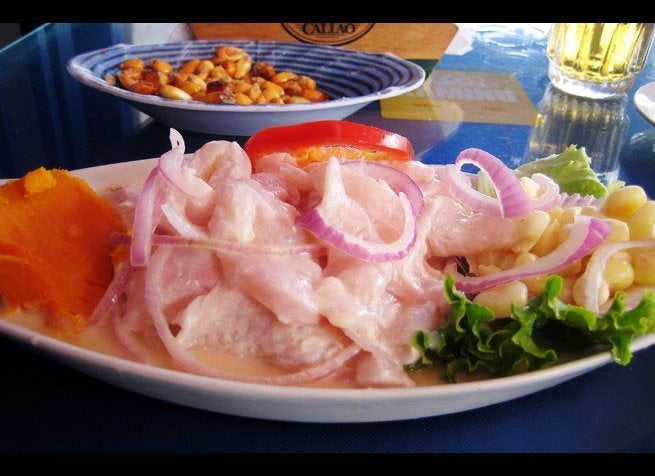
어디서 먹을까 : 페루 리마
최근의 음식 트렌드, '세비체'는 페루에서는 나라를 대표하는 음식으로 여겨진다. 세비체를 축하하는 기념일이 있을 정도니 말이다. 레시피는 간단하다. 싱싱한 생선회를 양파와 고춧가루 소금, 후추와 시트러스(감귤류) 주스에 넣어 준비가 끝나자마자 서빙한다. 농어가 가장 전통적으로 많이 이용되는 생선인데 수도 리마에서는 가자미를 선호한다. 고구마와 양상추 옥수수 아보카도와 함께 서빙된다.
Plan Your Trip: Visit Fodor’s Lima Travel Guide
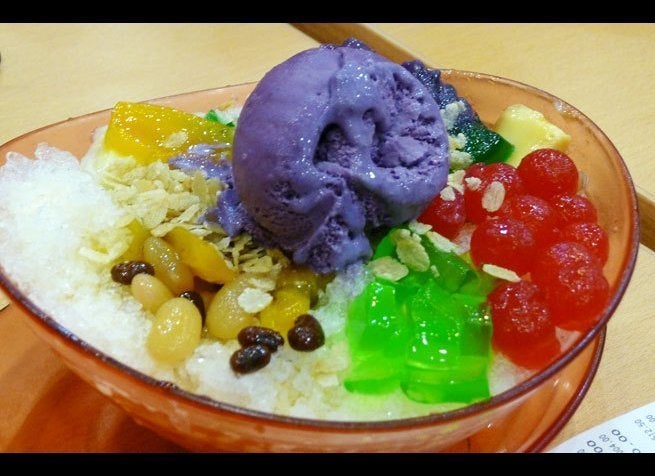
어디서 먹을까 : 필리핀
번역하자면 '섞어-섞어'다. 할로할로는 필리핀식 팥빙수라고 할 수 있다. 얼음과 연유는 기본이고 그 외 어떤 것이든 할로할로의 재료가 된다. 완벽하지는 않지만, 할로할로에 넣을 수 있는 재료의 목록은 다음과 같다. 팥, 병아리콩, 사탕야자 열매, 코코넛, 카라멜에 절인 과일 플랜테인, 열대 과일 잭프루트, 녹말로 만든 타피오카, 고구마, 쌀가루, 플랜(푸딩), 아이스크림. 괴이한 음식같아 보이지만 동남아시아와 동아시아 어디에서든 쉽게 볼 수 있는 음식이다.
Plan Your Trip: Visit Fodor’s Philippines Travel Guide